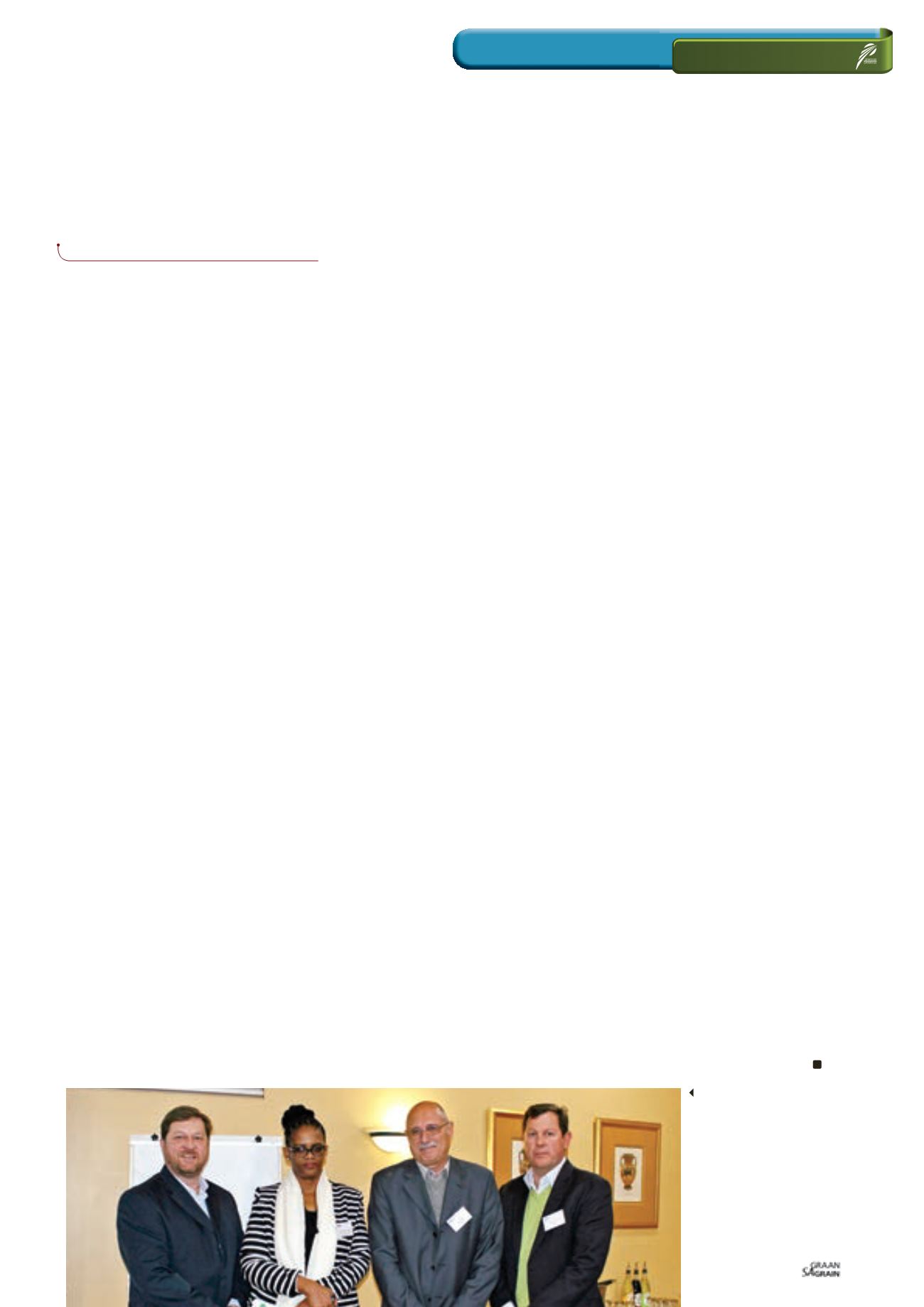

for a proϐitable silo industry
P
rofit, being one of the triple bot-
tom line measures of sustainabil-
ity, was one of the subjects that
was discussed at this year’s Agbiz
Grain Mini Symposium that took place on
10 August in Pretoria.
‘We need to plan sustainable strategies
that are viable, equitable and bearable;
these strategies need to be taken into ac-
count when working with profit, people
and the planet,’ Mr Jerry Maritz (chairman:
Agbiz Grain) said.
Mr Nico Hawkins (general manager:
South African Grain Information Service
[SAGIS]) addressed Agbiz Grain members
and other silo industry role-players, review-
ing the 2015/2016 season grain movement
per province according to each commodity
(referred to as ‘imports’ and ‘exports’).
Approximately 80% of all maize in South
Africa was in the silos on 1 May 2015 and
by the end of April 2016 the stock was at
73%. ‘The difference in the opening and end
stock can be attributed to the smaller crop
during this season,’ Hawkins explained.
The Free State and North West Province
were the main contributors of white maize
for both production and processing in the
2015/2016 season. ‘The Free State is the
biggest processor and the biggest exporter
of white maize in South Africa. This prov-
ince processed 1,2 million tons of white
maize and had a surplus of 978 804 tons
that were exported to other provinces who
had a shortage of white maize. The North
West Province was next in line, processing
863 607 tons of white maize and exporting
182 393 tons to other provinces,’ he said.
According to Hawkins, yellow maize is pro-
cessed countrywide, but it is not as con-
centrated with regards to processing as
white maize. ‘Most of the yellow maize was
processed in Gauteng, which is also a big
importer of yellow maize. They produced
close to 300 000 tons in the 2015/2016
year. The North West Province and Eastern
Cape were both short on yellow maize and
had to import from other provinces.’
Gauteng was by far the biggest process-
ing province of wheat, soybeans and sun-
flower seed in South Africa. ‘This province
had a shortage of 676 483 tons of wheat in
the 2015/2016 season. Processors derived
most of their wheat from imports. Gau-
teng processed 586 236 tons of soybeans,
but had to import almost everything that
was processed – there was a shortage of
484 176 tons. There was also a sunflow-
er seed shortage of 427 681 tons, which
were mostly imported from the Free
State and North West Province. A total of
444 091 tons of sunflower seed were pro-
cessed in Gauteng.’
Mr Chris Sturgess (director: Commodity
Derivatives, Johannesburg Stock Exchan-
ge) emphasised the importance of delivery
in the derivatives market. ‘Physical deliv-
ery and storage infrastructure can have a
profound impact on the economics of the
futures markets, such as the cost of carry-
ing the derivatives contract, convergence
between the derivative and the physical
market prices and the premiums for each
of the contract’s delivery points.’
He said that secure delivery is made pos-
sible by consistent government policy sup-
porting the free market and the movement
of commodities, defined grading standards
recognised by the industry, robust storage
operator agreements committed to hon-
ouring storage obligations, clearly defined
requirements for storage operators and
efficient and secure settlement systems to
effect transfer of ownership of the com-
modities.
Mrs Vivian Phadime (deputy director: Direc-
torate Development Finance Co-ordination,
Department of Agriculture, Forestry and
Fisheries) addressed the role of government
in providing a safety net through agricul-
tural insurance. ‘The Department of Agri-
culture, Forestry and Fisheries (DAFF), in
collaboration with the National Treasury,
is exploring the feasibility of introducing
a state-supported agricultural insurance
scheme. This scheme will assist South
African producers in managing the risks
threatening their productivity and incomes
in the sector.’
Mr Christiaan Winckler (professional quan-
tity surveyor and valuer: Valuers Afrika),
specialising in valuations of immovable
property, presented information based on
his Master’s thesis (Real Estate) that was
done at the University of Pretoria. The study
entailed the valuation of silos. ‘Income
capitalisation is the only method that can
be accurately applied to the valuation of
grain silos, but this method cannot be ap-
plied in its standard form. Some adjust-
ments have to be made to allow for the spe-
cialised nature of a silo,’ he said.
One of the adjustments includes the in-
come that needs to be normalised and cal-
culated to allow for fluctuations in demand.
‘The yield in an area has a direct influence
on the demand for storage space and the
potential income. To apply the occupancy
of the previous year would give an incor-
rect value due to the differences from year
to year. Demand thus has to be normalised
to determine the most likely income that the
silo can have in the next year,’ he explained.
His solution is to use the occupancy over
a long term and then determine the aver-
age percentage occupancy. The income of
storage is then determined by using the fol-
lowing calculation: Capacity of silo (tons) x
Occupancy (%) x R/ton per day x 365 days.
All the presentations that were made at the
Agbiz Grain Mini Symposium under this
year’s theme “Triple bottom line: People,
profit, planet” are available on the Agbiz
Grain website at
http://agbizgrain.co.za/en/information/mini-symposium-2016
.
93
October 2016
RELEVANT
RUTH SCHULTZ,
SA Graan/Grain
contributor
Jerry Maritz, left, with some
of the speakers who presented
on the profit theme at the
Agbiz Grain Symposium. Next
to Maritz is Vivian Phadime,
Nico Hawkins and
Chris Sturgess.

















